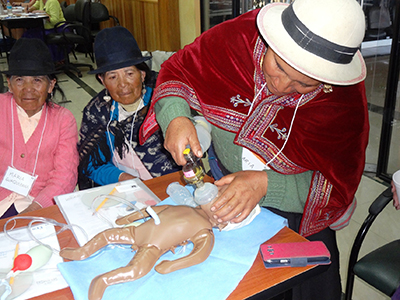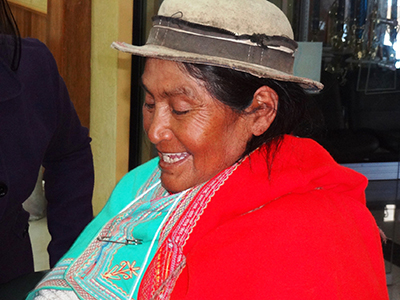LDS Medical Team Trains Midwives in Newborn Resuscitation
Contributed By Elder Joel E. Greer, Church News contributor

More than 50 indigenous midwives from various villages traveled three hours by bus over unpaved roads for neonatal resuscitation training provided by the Church.
Article Highlights
- The local ministry of health invited community midwives from isolated villages to participate in a two-day training titled Helping Babies Breathe.
- A group of over 50 of these indigenous midwives arrived, which was unusual as most indigenous communities are mistrustful of western medicine and philosophy.
- The midwives learned quickly and were very eager to try these practices in their villages.
As a part of the Church’s ongoing effort to reduce infant mortality in remote parts of the world, a specially selected medical team traveled to Guaranda, Ecuador, for a neonatal resuscitation project.
In the early part of the week, pediatricians, obstetricians, and obstetric nurses received an intensive two-day advanced neonatal resuscitation course organized and taught by Dr. Frank Bentley and a specialized team of doctors and nurses selected from different parts of the U.S.
Dr. and Sister Bentley have been called as neonatal resuscitation specialists by the Church and have traveled extensively throughout the world to conduct these sessions for medical personnel in less-developed countries.
Guaranda, Ecuador, is remotely located at the base of Chimborazo, the third-highest volcano in the world, and although a small community itself, it is surrounded by many extremely poor indigenous villages of local native Quechua tribes. The area boasts a 3–5% infant mortality rate, but in the remote villages it is generally accepted to be far higher. It is difficult to determine exact rates because mortality records are not maintained.
The local ministry of health invited community midwives from these isolated villages to participate in the second more basic two-day training known as Helping Babies Breathe. These midwives have never been exposed to any type of formal training and typically are taught by their mothers how to deliver babies within the community.
Maria Luisa Guaquipana of Caseyche, who has been a midwife for over 20 years, shared that she was taught by her mother, who was taught by her mother, as they traveled by horseback to deliver babies in their remote village. The techniques are passed on from generation to generation. Due to the remoteness of their village, those techniques rarely include the benefit of medical advances in neonatal care.
When asked how they resuscitate a newborn, she responded that they generally placed two drops of hot water on its tongue in hopes of a response. With no equipment and often bereft of even the basic services of electricity and running water, these Incan midwives provide the best service they can; however, the result is an exceptionally high mortality rate among the indigenous communities.
A group of over 50 of these indigenous midwives arrived after more than a three-hour bus ride over unpaved roads from their individual villages. All were dressed in their native costumes and came prepared to learn what they could to improve their skills, which was unusual as most indigenous communities are very mistrustful of western medicine and philosophy.
Dr. Bentley stated that in all the trainings throughout the world that he has directed, they have never been able to convince a group of indigenous practitioners to attend a training. “The difference these indigenous midwives will make to reduce the mortality rate of newborns by applying the techniques being taught here makes the whole trip worthwhile.”
Dr. Bentley’s neonatal resuscitation team went straight to work, and through didactic as well as practical exercises, these midwives showed an exceptional ability to learn and apply the teachings. They were eager and excited about what they learned. When presented with the most basic equipment of a suction bulb and bag and mask ventilator, the participants immediately wanted to know how they could receive such wonderful tools. Fortunately, the Church donates large amounts of this type of equipment to participants of these trainings, as well as far more sophisticated equipment to physicians and hospitals, all of which is used to reduce infant mortality in countries such as Ecuador.

When presented with the most basic equipment of a suction bulb and bag and mask ventilator, the participants immediately wanted to know how they could receive such wonderful tools. Fortunately, the Church donates large amounts of this type of equipment to participants of these trainings. Photo by Joel E. Greer.

Dr. Bentley demonstrates to the midwives how to resuscitate a newborn. Photo by Joel E. Greer.

Dr. Punina is the health director. Photo by Joel E. Greer.

“The difference these indigenous midwives will make to reduce the mortality rate of newborns by applying the techniques being taught here makes the whole trip worthwhile.” —Dr. Bentley. Photo by Joel E. Greer.

The midwives enjoyed the training they received. Photo by Joel E. Greer.
